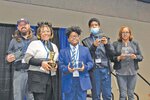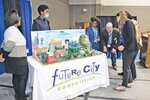


Dream, Imaginations, and Gifts (DIG) dreamers brought third place home to Williston in this year’s South Carolina Future City Regional Competition in the first in-person event since the pandemic.
Held by the Department of Energy and Savannah River Nuclear Solutions (SRNS), this year's Future City competition asked young minds across the state and the city of Augusta, Ga. to explore how cities of the future can best mitigate the challenges of climate change.
For the past 20 years, middle school aged students in teams of three build model cities of the future through research and design with sustainability in mind alongside a 1,500-word essay describing their city and ways to enact change to then be presented to a panel of judges.
"Designing a city of the future is a difficult task for anyone, much less these young and enthusiastic students who have boldly taken on this challenge," said Taylor Rice, Savannah River Nuclear Solutions (SRNS) Education Outreach. "Providing an effective way to offer long-term protection from the effects of global climate change can be a significant task for those studying environmental science in college. The Future City competitors used creativity, imagination and ingenuity to create the cities we’re judging today. Their projects are very impressive."
To complete this year’s challenge of combating climate change, DIG dreamers created the city of Contraxia complete with functioning wind turbines, a working monorail, a universal air filter, and much more.
The creators of Contraxia are sixth graders Rodney Holmes, Ra’Jiyah James, Teaonia Thomas, and Riquasia Mack, and eighth grader Kanye Ford. Holmes, Ford, and Mack presented at the competition held at the University of South Carolina Aiken campus. Mack played a major role in the construction of the city, but moved schools shortly after the competition presentation.
Contraxia, a name derived from the movie series Guardians of the Galaxy, is built entirely of discarded household materials such as food containers, packaging products, and other things one might throw away. The city of the future was founded in the year 2133.
The Future City team worked on the model from September when that year’s topic was announced to mid-January when the competition was held. Each team is granted a budget of $100.
“We used yogurt cups, ketchup containers, and salad bowls. We were telling them to bring in their garbage,” said Charlette Epps, DIG site coordinator. “They brought trash and made beauty out of it.”
The city is broken up into three parts; the energy producing section, entertainment and recreation, and academic and emergency services. Each of these sections was thoroughly researched by the team to determine how it played into their mission to solve climate change.
Within the energy producing section there is a nuclear facility, wind turbine, solar field, hydroelectric dam, farms, and farmers market located near restaurants for organic eating.
Holmes, the mayor and sixth grader, explained how each facet of the first section worked effectively within the city limits and broke down the inner workings of a nuclear facility that will power the city for over 50 years.
“The reason that we chose these energy production ways is because they release no fossil fuels or greenhouse gasses,” said Holmes, who also explained there is no need for large trucks to enter the city and emit gasses as nearly everything they need is produced within such as food from their farms.
The working monorail is the primary method of transportation for Contraxia citizens.
Contraxia also comes complete with a universal air filter which aids in the city’s goal of combating climate change.
“The battery sits on top of the air filter, and the air filter filters carbon coming from outside areas so that everytime carbon enters the atmosphere it filters it out and gives it to the windmills which can use it to their advantage to keep giving oxygen to the trees and keep making our city greener and greener,” said Ford.
James is the assistant mayor of Contraxia, and explained the different aspects of the residential, entertainment, and recreation region of the city.
“We have a three-tier entertainment system,” said James. The bottom level is a shopping center, the middle is stocked with movie theaters and entertainment, and the top is restaurants. Next to this area is an apartment complex for those who may not want to live in the rural area of Contraxia.
Along with solar panels on top of houses, they also have greenery growing on roofs to help with sustaining the bees.
Another key part of Contraxia is the DIG building made of popsicle sticks, where students in the city can come to learn and grow.
Ford explained the aspects of Contraxia’s DIG school that teaches individuals of all ages. This differs from the actual DIG program as students graduate after completing eighth grade.
Ford was also heavily responsible for the 1,500-word essay.
“He did a really good job pulling in sources and futuristic information from different places,” said DIG Site Coordinator William Shipes of Ford’s work on the essay.
Shipes worked alongside students to figure out how to implement ideas like a nuclear facility, hydroelectric dam, and a lunar gravity battery that powers the city.
“You would think, looking at this [project], that an adult mind might have better ideas than a child’s mind, but a child’s mind is a bit more free to roam so they had ideas that I could never ever fathom,” said Shipes. “Sometimes they would give me an idea and I didn't know what it was, so I’d have to go and research it so that I could tell them how it worked.”
When Shipes or Epps could not break down a topic to the one inch per 100-foot scale the students were working on, they would bring in an expert.
This year the students invited a nuclear specialist from the Savannah River Site to explain how nuclear energy works on a large scale, impacts our environment, and affects climate change. It was then up to the students to figure out how to make it work on their scale.
Although the students were able to bring the majority of their ideas to fruition, there were a couple ideas that stumped Shipes.
“They wanted to do a teleportation system, I couldn't figure that out because I couldn't figure out how to make things teleport,” said Shipes with a laugh.
Dreamers also hoped their working monorail would travel through a plastic tube, but after working for nearly two months to make it happen, they took another route using a string and pulley method.
“Helping them integrate those ideas into the actual model, that was my favorite part,” said Shipes.
This is DIG’s tenth year participating in Future City, and each year the students look forward to creating something new.
“My favorite part about this is seeing them go from being uncertain of what the task was to realizing that they can do anything they put their mind to,” said Epps. “Also learning new terminology and seeing how the real world will work in the future.”
"A resilient city ensures its residents are safe and can meet the challenges of the future," said Rice. "With the guidance of an educator and STEM mentor, each Future City team during this year's competition has gained immeasurable experience and knowledge that will prepare them for even greater accomplishments that lie ahead, and hopefully, one day, a career at the Savannah River Site."
“I felt like we were really close to winning this year, we were only a few points away from first place,” said Shipes. “They’ve got some crazy ideas for next year.”
The team of DIG dreamers came in third overall and won two special awards: Best City Model and Best Energy System. They celebrated this win on February 8 at First Baptist Church in Williston where the team presented their city to parents and other educators.
McCracken Middle School in Spartanburg placed first and Risen Christ Christian Academy in Myrtle Beach placed second. Regional winners will face off at the finals in Washington, D.C. in February.
Visit DIG on Facebook to watch these students explain the inner workings of Contraxia and for more information on the Future City Competition, visit https://futurecity.org/.